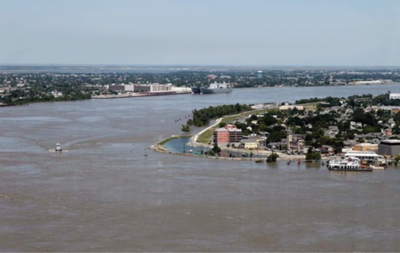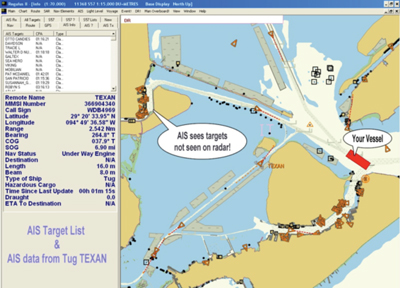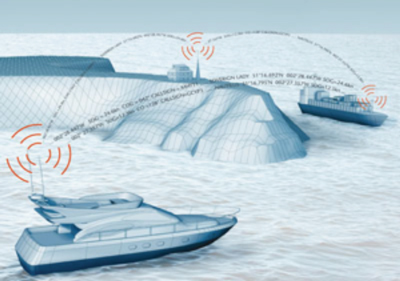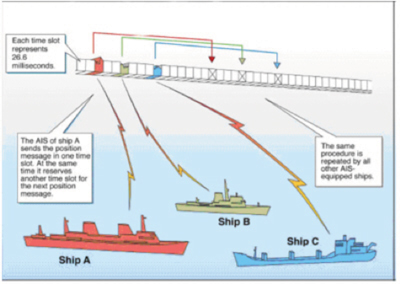| Rounding the turn downbound at Mulatto Bend, the towboat helmsman is suddenly faced with the piers of the Huey P. Long Bridge at Baton Rouge. (Photo courtesy of U.S. Coast Guard Petty Officer 1st Class Chris Botello) |
If we are shipping a load of coal down the Lower Mississippi River, we simply assume all of our barges will arrive safe and sound, never giving a second thought to the danger they endured. In most cases, they will arrive safely because the downriver pilots are the best of their profession, their crews are continuously vigilant, and their towboats are equipped with sufficient power and the best hazard detection equipment available. It is certainly not the only dangerous place on the inland waterways — some may argue the Cincinnati area on the Fourth of July may outrank it for danger to pleasure craft — but the Lower Mississippi River is always hazardous.
The Lower Mississippi is a veritable gauntlet of nautical hazards from Baton Rouge to the Gulf. A barge tow captain rounding the turn at Mulatto Bend (Baton Rouge) is suddenly faced with a moving maze of danger that will not ease up until his barges are safely parked beside the river bank, miles downstream. The captain and crew must know what lies ahead, starting with the piers of the Huey P. Long Bridge only a mile beyond the bend. They need all the information their lookouts can provide, especially when it is a foggy night during high water.
The Lower Mississippi River is 200 miles of very busy water. There are terminals on both river banks: the water is so deep, large ocean vessels can navigate safely, and there are barge tows of every type. The waters are so treacherous incoming ocean vessels must hire professional river pilots to guide them to all points between Southwest Pass Sea Buoy and Baton Rouge. Many ships are moving, some are anchored, for midstream or dockside loading, and some are anchored awaiting terminals to clear. Hundreds of loaded or empty barges may be parked by the river bank in fleeting areas, and numerous smaller vessels abound.
 |
| Algiers Point is a famous hazard downstream a short distance from New Orleans. This is the Mississippi River during the 2011 flood, facing downbound. Note some of the hazards that might be encountered by a downbound coal tow: a terminal on the far riverbank, two ships anchored near the terminal, the Algiers ferry and terminal, the Algiers levee and a small vessel in mid-river. (Photo courtesy of David Grunfeld, The Times-Picayune) |
It’s tricky enough to avoid all the nautical hazards in the daylight, when the river is only moving at 1-2 miles per hour, but when the river is flooding and moving fast, the Lower Mississippi is no place for ordinary pilots. Hazard detection and communication is paramount, and one must use every available means, which includes all instruments. Under normal conditions, a line-haul towboat (9,000-11,000 hp) may depart Cairo southbound with a 40-barge tow of coal; during flood conditions, the Coast Guard may advise the towing company to cut their maximum tow size to 20 barges because of safety concerns.
Captain Jerry Tinkey, former vice president of operations for Ingram Barge, put it this way: “Always remember the four A’s: Anticipate, Assess, Adjust and Apply.” That means the helmsman should use every bit of instrumentation provided for hazard detection, and if one man cannot do it alone, a proper lookout may require another man in the wheelhouse to watch instruments while the captain or the mate watches the river. In the modern world of barge towing, that means the instrument panel contains a radio, the very latest river radar, and possibly a relative newcomer to the rivers, the Automatic Identification System (AIS).
What if he was pushing a 1,000-ft tow down the Lower Mississippi on a foggy night and could not see the Huey P. Long Bridge just a mile around Mulatto Bend at Baton Rouge? Barges have no keel, so he cannot steer them. Instead, he must literally apply backward thrust to the towboat and tow, causing the barges to swing in an opposite direction and allowing the force of the current to direct the trajectory of the barge tow. Rivermen call this operation “setting the tow.”
At a typical current velocity of 3 mph, he would have a half hour to set the tow at a proper angle to ride the 300-ft wide channel safely through the bridge piers; at a speed of 6 mph, he would have only 15 minutes to set the tow. This is a perfect illustration of why a powerful (10,000 hp) engine is needed to apply reverse thrust to the tow, and why the Coast Guard advised him to cut the size of his tow. If the tow were twice as long and the towboat had less power, he might not be able to set the tow fast enough to avoid the bridge piers.
THE LOOKOUT DUTY
Rule No. 5 of the International Regulations for Preventing Collisions at Sea (COLREGS) states, “Every vessel shall at all times maintain a proper lookout by sight and hearing as well as by all available means appropriate in the prevailing circumstances and conditions so as to make a full appraisal of the situation and of the risk of collision.” The lookout requirement is worded identically in the Inland Rules. Another way of putting it is Captain Tinkey’s “four A’s.”
The text of Rule 5 stresses the lookout role in facilitating a full appraisal of the situation and the risk of collision. The lookout duty has been described as “the first rule of safe navigation.” In an 1865 decision concerning a collision between a steamship and a brig outside New York Harbor, the Supreme Court said, “Upon nothing else does the safety of those concerned so much depend. A moment’s negligence on his (the lookout) part may involve the loss of his vessel with all the property and the lives of all on board. It is the duty of all courts charged with the administration of this branch of our jurisprudence to give it the fullest effect whenever the circumstances are such to call for it application.”
The defendant in a collision/allision case should not look for a special exemption because of extremely bad weather, or because he had a very small boat, or because he had to go wake up the next watch, or because he was killing the boredom with a computer game, or because he had to make a head call, or because he was on a vessel at anchor. He should not look for special dispensations or for sympathy. The Supreme Court has spoken, and even though it was 150 years ago, their word is still Holy Writ. He should not expect an admiralty court or any other court to overthrow Holy Writ if his case goes to court. This is perhaps overstating the attitude of admiralty courts a bit, but the defendant should be aware that courts take the matter of maritime safety very seriously.
AUTOMATIC IDENTIFICATION
Since July 1, 2004, Vessel Traffic Services (VTS) Lower Mississippi River has required vessels of 50,000 gross tons or more on international voyages to carry AIS equipment. However, despite rulemaking that has been pending since 2008, and despite the safety and other advantages of AIS that have become apparent since its limited mandated carriage, the technology is not yet required on all the inland waterways. Almost six years ago, the American Waterways Operators (AWO) endorsed a proposed USCG ruling requiring AIS carriage on the inland waterways (April 15, 2009, letter, AWO to USDOT). On December 24, 2015, the White House Office of Information and Regulatory Affairs (OIRA) completed its review of the NOAD-AIS rule. The rule now awaits the commandant’s signature prior to it being published in the Federal Register. Many inland vessels have already installed AIS equipment, either because they operate within VTS areas or because the owners have seen the benefit of carrying the equipment voluntarily.
The U.S. Coast Guard’s “Vessel Requirements for Notices of Arrival and Departure (NOAD) and Automatic Identification System (AIS) [USCG-2005-21869]” final rule regarding expansion of NOAD and AIS requirements in the U.S. is currently under EO 12886 Regulatory Review at OIRA — this is the final review prior to its publication. Most OIRA reviews take less than 90 days; this was a notice that this rule may be published prior to its current Semi-Annual Unified Regulatory Agenda prognostication, December 2014. (As of the date of this publication, the rule had not yet been published.)
 |
| Monitor display showing AIS targets not seen on radar. (Image courtesy of USCG NAVCEN) |
What is AIS? Picture a wheelhouse radar or an electronic chart display that includes a symbol for every significant ship within radio range, each as desired with a velocity vector (indicating speed and heading). Each ship “symbol” can reflect the actual size of the ship, with position derived by GPS or differential GPS. By “clicking” on a ship symbol, one can learn the ship name, course and speed, classification, call sign, registration number, Maritime Mobile Service Identity (MMSI) and other information. Maneuvering information, closest point of approach (CPA), time to closest point of approach (TCPA) and other navigation information, augmenting that available from an automatic radar plotting aid, can also be provided by navigation software using the AIS input.
With this information, one can call any ship over VHF radiotelephone by name, rather than by “ship off my port bow” or some other imprecise means (who knows where your port bow is if they cannot see you?). One can dial it up directly using GMDSS (Global Maritime Distress and Safety System) equipment. One can send to the vessel, or receive from it, short safety-related email messages. That tow approaching Mulatto Bend can identify and communicate with a ship that is anchored just beyond the bridge piers on a foggy night.
The inland edition of JRC’s JMA-5300MK2 radar is a result of listening carefully to river boat captains and owners, and was developed specifically for the river boats. AIS is not better than radar, but radar is blind to targets not within a line of sight trajectory, and AIS is not. AIS can supply target (or hazard) information that radar cannot see; thus, it improves the “available means” required by Rule 5. It can “see” the piers of the Huey P. Long Bridge and nearby vessel traffic long before radar picks them up.
The AIS is a shipboard broadcast system that acts like a transponder operating in the VHF maritime band, capable of handling 4,500 reports per minute and updating as often as every two seconds. It uses Self-Organizing Time Division Multiple Access (SOTDMA) technology to meet this high broadcast rate and ensure reliable ship-to-ship operation.
Each station determines its own transmission schedule (slot), based on data link traffic history and knowledge of future actions by other stations. A position report from one AIS station fits into one of 2,250 time slots established every 60 seconds (60 seconds = 1 frame). AIS stations continuously synchronize themselves to each other to avoid overlap of slot transmissions. Slot selection by an AIS station is randomized within a defined interval, and tagged with a random timeout of between zero and eight frames. When a station changes its slot assignment, it pre-announces both the new location and the timeout for that location. In this way, new stations (e.g., towboats), including those stations that suddenly come within radio range close of other vessels, will always be received by those vessels.
The required ship reporting capacity according to the IMO performance standard amounts to a minimum of 2,000 time slots per minute, but the AIS system provides 4,500 time slots per minute. The SOTDMA broadcast mode allows the system to be overloaded by 400 to 500% and still provides nearly 100% throughput for ships closer than 8 to 10 NM to each other in a ship-to-ship mode. In the event of system overload, only targets further away will be subject to drop-out in order to give preference to nearer targets that are a primary concern to ship operators. In practice, the capacity of the system is nearly unlimited in the ship-to-ship mode, allowing for a great number of ships to be accommodated at the same time.
The system coverage range is similar to other VHF applications, essentially depending on the height of the antenna and the power of the transmitter. Its propagation is slightly better than that of radar, due to the longer wavelength, so it’s possible to “see” around bends and behind islands if the land masses are not too high. A typical value to be expected at sea is nominally 20 nautical miles, but such ranges are not usually required on the rivers.
 |
| An AIS-equipped vessel can see a target around a bend such as Mulatto Bend. |
 |
| Multiple vessels can rapidly synchronize their positions with one another. |
A MOMENT’S NEGLIGENCE
It was a bright warm Sunday morning on May 26, 2002. Downstream from the I-40 bridge fishermen on the Arkansas River heard a deafening crash in the vicinity of the bridge. They looked up to see that an enormous slab of the overhead interstate highway had fallen onto a barge. They watched helplessly as a west-bound semi flew through the yawning gap in the bridge deck and plunged 85 ft to the river, followed quickly by several other vehicles. Horrified, but realizing highway traffic was not seeing the gap, one of the fisherman desperately shot a signal flare that miraculously hit the windshield of a semi, causing it to come to a screeching stop at the edge of the yawning gap. Other vehicles then realized something was wrong and crammed on their brakes, but not before many vehicles had fallen.
A few seconds earlier, a two-barge Magnolia Marine tow had gone off course and slammed into a bridge pier. The towboat Robert Y. Love was piloted that day by a man who suffered from an ailment later described by the NTSB as syncope. The NTSB report stated that Captain Joe Dedmon remembers seeing the bridge ahead, recalls that the tow was in proper position with respect to the channel, but that he blacked out before making the necessary turn to starboard.
Tragically, the only man sharing the watch with the captain had just gone below to awaken the mate for his shift. For a few critical seconds, there was no effective lookout in the wheelhouse, no one to make a course correction. What was the probability that the captain would black out for 10 seconds during the same 10 seconds that his lookout went below? It was only 1 in 2.76 billion. It was truly “a moment’s negligence.”
The NTSB investigation showed there was no problem with wind or adverse weather. A blood test on the captain showed nothing irregular. The captain did not lose his license, but his guilt about the accident caused him to leave the river forever. Now what do we think of the Supreme Court’s 1865 decision? Do we still think it was too extreme? At a bridge too far west for many coal people to take notice, a barge collision with a bridge pier had resulted in the loss of 14 lives and tens of millions of dollars in losses and damages. Could it have happened on the Ohio, the Tennessee or the Mississippi Rivers with longer tows of coal barges and longer bridges?
Dave Gambrel is a private consultant in coal transportation and is the former director of transportation for Peabody Energy. Prior to entering the coal industry, he was an electronics engineer serving as a project manager for Honeywell Systems in Seattle.
Brian Tetreault is a navigation systems specialist for the U. S. Army Corps of Engineers Research and Development Center Coastal and Hydraulics Laboratory. His projects include developing navigation systems to improve safety, efficiency, and reliability of inland and coastal waterways.
Acknowledgement
The authors acknowledge the personal assistance given by Captain Jerry Tinkey and by the contribution of professor Craig Allen of the University of Washington, author of Farwell’s Rules of the Nautical Road, Eighth Edition.

